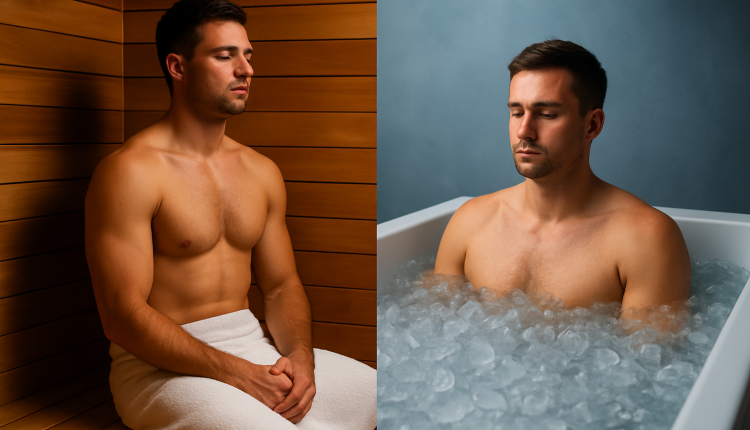Cold plunges, contrast showers, infrared saunas, cryotherapy, and classic steam rooms have turned into mainstream wellness rituals over the past decade. For many people these practices promise faster recovery, reduced soreness, lower stress and an overall sense of rejuvenation. But what does science actually say about exposing the body to extremes of heat and cold, and how can these techniques be incorporated safely into everyday life? Understanding the physiological mechanisms behind thermal stress helps distinguish meaningful benefits from hype — and reveals when these methods might not be appropriate.
How Heat Exposure Works: The Physiology of Saunas
Saunas — whether traditional Finnish, dry heat, steam, or infrared — work primarily by increasing core body temperature. As your internal temperature rises, blood vessels dilate, heart rate increases, and circulation improves. This triggers several cascades in the body:
• Improved blood flow and muscle relaxation.
Heat encourages vasodilation, delivering oxygen-rich blood to muscles and facilitating the removal of metabolic waste. This can reduce muscle tension and promote relaxation after workouts or long periods of stress.
• Cardiovascular conditioning.
Some research suggests regular sauna use mimics moderate cardio by temporarily increasing heart rate and improving vascular elasticity. Over time, this can support long-term cardiovascular health.
• Stress reduction through neurochemical changes.
Saunas promote the release of endorphins and help regulate cortisol levels. Many users describe a calmer mood and improved sleep after heat sessions.
• Enhanced detoxification — but with caveats.
While sweating removes some substances, detoxification remains a liver- and kidney-dominated process. Saunas can complement detox efforts but should not replace proper medical care or hydration habits.
The Scientific Role of Cold Therapy
Cold therapy, in contrast, triggers vasoconstriction and activates the sympathetic nervous system. The body reacts instantly to preserve heat, which leads to distinct physiological responses:
• Reduced inflammation and swelling.
Cold is a well-known anti-inflammatory tool. Athletes often use ice baths or cryotherapy after intense sessions to lower muscle swelling and shorten recovery time.
• Increased alertness and improved mood.
Cold exposure stimulates the release of norepinephrine, a neurotransmitter linked to heightened focus and a sense of wakefulness. Anecdotally, many people also describe a slight mood lift after cold plunges.
• Accelerated recovery — in specific contexts.
Cold therapy seems most effective for acute pain, intense training cycles, and very strenuous exercise. It may not be needed or beneficial for everyday low-intensity workouts, and excessive use can blunt muscle growth if applied immediately after strength training.
• Brown fat activation.
Regular cold exposure can stimulate brown adipose tissue, improving metabolic function and supporting thermoregulation. While not a weight-loss magic solution, it may contribute to overall metabolic health.
Heat vs. Cold: When Each Works Best
Use heat when you want to…
• Relax your muscles
• Improve circulation
• Reduce stress or anxiety
• Support recovery from mild soreness
• Prepare the body before stretching or mobility work
Use cold when you need to…
• Reduce inflammation
• Control swelling after injury or intense exercise
• Boost alertness or mood
• Recover after high-intensity sports sessions
Both methods interact with different parts of the nervous and circulatory systems. For many people, the best results come not from choosing between them but from timing them properly.
The Power of Contrast Therapy
Alternating between hot and cold — contrast showers, hot saunas followed by cold plunge — takes advantage of vascular pumping. Heat expands blood vessels, cold contracts them, creating a rhythmic “flush” that may improve circulation and accelerate muscle repair.
This technique is especially favored by athletes or individuals who regularly undergo high physical stress. However, contrast therapy should be introduced gradually, as rapid shifts in temperature may be overwhelming for beginners.
When Thermal Therapies Can Be Unsafe
While saunas and cold exposure are widely considered safe for healthy individuals, certain situations require caution:
Avoid or limit these practices if you have:
• Cardiovascular disease or uncontrolled hypertension
• Respiratory conditions triggered by temperature changes
• Pregnancy (requires medical approval)
• Nerve disorders that impair temperature perception
• Open wounds or active infections
Also, dehydration is a common issue. Saunas cause significant fluid loss, and cold plunges can trigger temporary blood pressure spikes. Hydration before and after both practices is essential.
How to Safely Integrate Heat and Cold Into Everyday Life
1. Start slow with both heat and cold.
Begin with short sauna sessions (5–10 minutes) or brief cold exposure (10–20 seconds at the start). Let your body adapt.
2. Build up gradually.
Increase heat duration or reduce cold temperatures only when sessions feel comfortable.
3. Pair heat with rest days.
Saunas fit well into rest or recovery days, supporting circulation and relaxation.
4. Use cold strategically.
If muscle building is your goal, avoid cold therapy immediately after strength sessions—wait 4–6 hours.
5. Know your signals.
Dizziness, irregular heartbeat, numbness, or persistent discomfort mean it’s time to stop.
6. Use thermal tools as lifestyle enhancers, not cures.
They complement healthy habits — sleep, nutrition, movement, hydration — rather than substitute them.
Final Thoughts: The Balance of Heat and Chill
Heat and cold therapies tap into the body’s natural stress responses. When used mindfully, they offer powerful tools for recovery, mental clarity, and resilience. Saunas soothe the nervous system and promote circulation; cold strengthens alertness and reduces inflammation. Together, they create a balanced, holistic routine adaptable to different goals and lifestyles.
As interest in longevity and wellness continues to grow, understanding the science behind these practices allows individuals to use them safely and effectively — turning heat and chill into intentional tools for long-term wellbeing.
- Advertisement -

